SanDisk Extreme II Review (480GB, 240GB, 120GB)
by Anand Lal Shimpi on June 3, 2013 7:19 PM ESTRandom Read/Write Speed
The four corners of SSD performance are as follows: random read, random write, sequential read and sequential write speed. Random accesses are generally small in size, while sequential accesses tend to be larger and thus we have the four Iometer tests we use in all of our reviews.
Our first test writes 4KB in a completely random pattern over an 8GB space of the drive to simulate the sort of random access that you'd see on an OS drive (even this is more stressful than a normal desktop user would see). I perform three concurrent IOs and run the test for 3 minutes. The results reported are in average MB/s over the entire time. We use both standard pseudo randomly generated data for each write as well as fully random data to show you both the maximum and minimum performance offered by SandForce based drives in these tests. The average performance of SF drives will likely be somewhere in between the two values for each drive you see in the graphs. For an understanding of why this matters, read our original SandForce article.
If we look at the raw random read/write speed, SanDisk does fairly well but not quite to the level of Samsung's SSD 840 Pro.


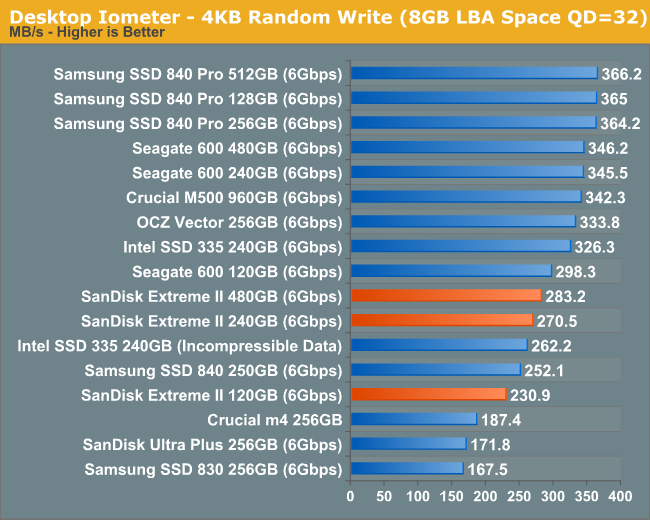
Sequential Read/Write Speed
To measure sequential performance I ran a 1 minute long 128KB sequential test over the entire span of the drive at a queue depth of 1. The results reported are in average MB/s over the entire test length. Sequential IO performance is very good on the Extreme II, effectively equalling the performance of Samsung's SSD 840 Pro.
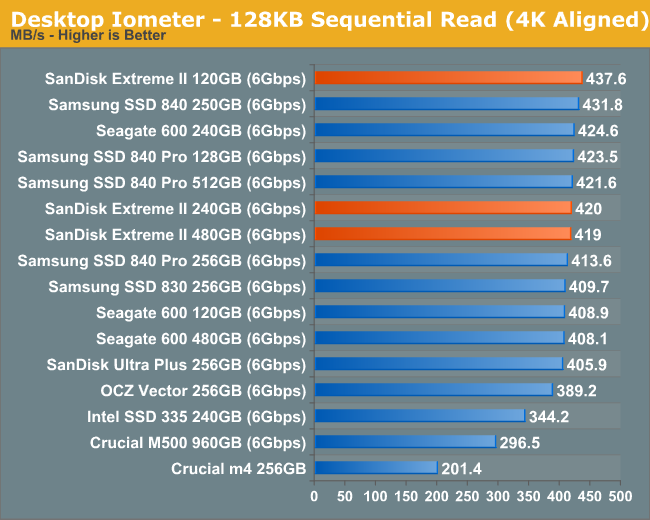
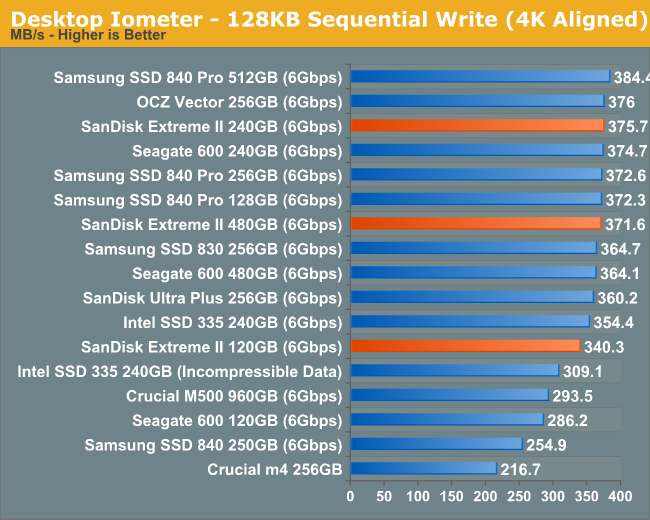
AS-SSD Incompressible Sequential Read/Write Performance
The AS-SSD sequential benchmark uses incompressible data for all of its transfers. The result is a pretty big reduction in sequential write speed on SandForce based controllers.
As a client focused drive, it's no susprise that the Extreme II does well in all of the sequential tests. I did notice consistently higher sequential read performance on the lower capacity Extreme II for some reason, but the gap isn't large enough to be significant. On the sequential write side, the 120GB drive is appreciably slower than the 240 and 480GB models simply because of the reduction in NAND die count.
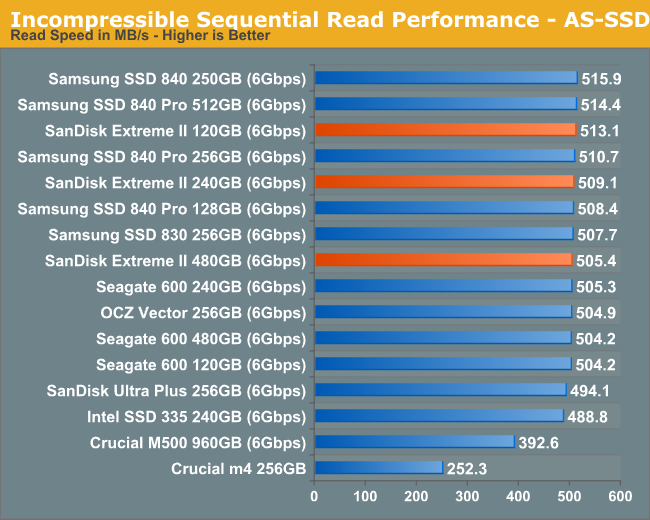
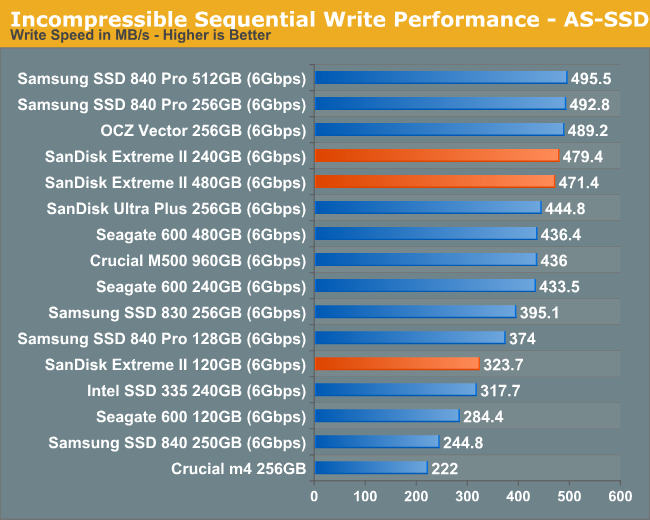










51 Comments
View All Comments
jhh - Monday, June 3, 2013 - link
I wish there were more latency measurements. The only latency measurements were during the Destroyer benchmark. Latency under a lower load would be a useful metric. We are using NFS on top of ZFS, and latency is the biggest driver of performance.jmke - Tuesday, June 4, 2013 - link
there is still a lot of headroom left; storage is still the bottleneck of any computer; even with 24 SSDs in RAID 0 you still don't get lightening speed.Try a RAM drive which allows for 7700Mb/s write speed and 1000+mb/s at 4k random write
http://www.madshrimps.be/vbulletin/f22/12-software...
put some data on there, and you can now start stressing your CPU again :)
iwod - Tuesday, June 4, 2013 - link
The biggest bottleneck is Software. And even with my SSD running in SATA 2, my Core2Duo running Windows 8 can boot just 10 seconds. And Windows 7 within 15 seconds. With my Ivy Bridge +SATA 3 SSD running 1 - 2 seconds faster on boot time.In terms of consumer usage, 99% of us will properly need much faster Seq Read Write Speed. We are near the end of Random Write improvement. Where Random Read we could do with a lot more increase.
Once we move to SATA Express with 16Gbps, we could be moving the bottleneck back to CPU. And Since we are not going to get much more IPC and Ghz improvements, we are going to need software written with Multi Core in mind to see further improvement gains. So quite possible the next generation of Chipset and CPU will be the last of this generation before we have software move to Multi Core paradigm. Which, looking at it now is going to take a long time.
glugglug - Tuesday, June 4, 2013 - link
Outside of enterprise server workloads, I don't think you will notice a difference between current SSDs.However, higher random write IOPS is an indicator of lower write amplification, so it could be a useful signal to guess at how long before the drive wears out.
vinuneuro - Tuesday, December 3, 2013 - link
For most users, a long time ago it stopped mattering. In a machine used for Word/Excel/Powerpoint, Internet, Email, Movies, I stopped being able to perceive a difference day to day after the Intel X25-M/320. I tried Samsung 470's and 830's and got rid of both for cheaper Intel 320's.whyso - Monday, June 3, 2013 - link
Honestly for the average person and most enthusiasts SSDs are plenty fast and a difference isn't noticeable unless you are benchmarking (unless the drive is flat out horrible; bute the difference between a m400 and a 840 pro are unnoticible unless you are looking for it). The most important parts of an SSD then become performance consistency (though really few people actually apply a workload where that is a problem), power use (mainly for mobile), and RELIABILITY.TrackSmart - Monday, June 3, 2013 - link
I agree 100%. I can't tell the difference between the fast SSDs from the last generation and those of the current generation in day-to-day usage. The fact that Anand had to work so hard to create a testing environment that would show significant differences between modern SSDs is very telling. Given that reality, I choose drives that are likely to be highly reliable (Crucial, Intel, Samsung) over those that have better benchmark scores.jabber - Tuesday, June 4, 2013 - link
Indeed, considering the mech HDDs the average user out there is using is lucky to push more than 50MBps with typical double figure access times.When they experience just 150MBps with single digit access times they nearly wet their pants.
MBps isn't the key for average use (as in folks that are not pushing gigabytes of data around all day) it's the access times.
SSD reviews for many are getting like graphics card reviews that go "Well this new card pushed the framerate from 205FPS to an amazing 235FPS!"
Erm great..I guess.
old-style - Monday, June 3, 2013 - link
Great review.I think Anand's penchant for on-drive encryption ignores an important aspect of firmware: it's software like everything else. Correctness trumps speed in encryption, and I would rather trust kernel hackers to encrypt my data than an OEM software team responsible for an SSD's closed-source firmware.
I'm not trying to malign OEM programmers, but encryption is notoriously difficult to get right, and I think it would be foolish to assume that an SSD's onboard encryption is as safe as the mature and widely used dm-crypt and Bitlocker implementations in Linux and Windows.
In my mind the lack of firmware encryption is a plus: the team at SanDisk either had the wisdom to avoid home-brewing an encryption routine from scratch, or they had more time to concentrate on the actual operation of the drive.
thestryker - Monday, June 3, 2013 - link
http://www.anandtech.com/show/6891/hardware-accele...I'm not sure you are aware of what he is referring to.